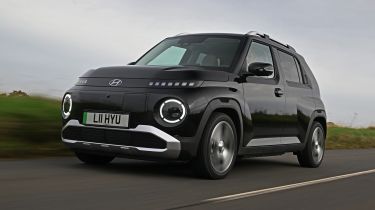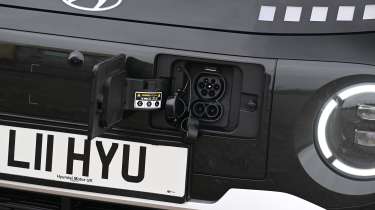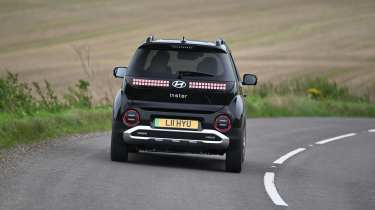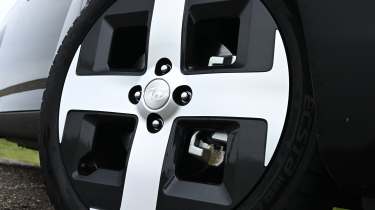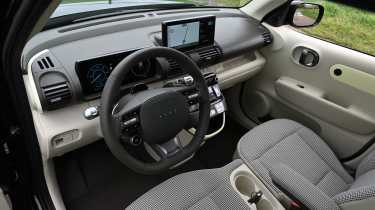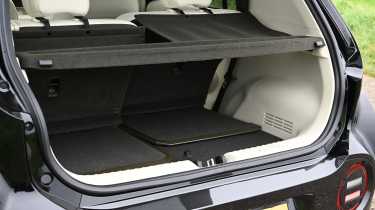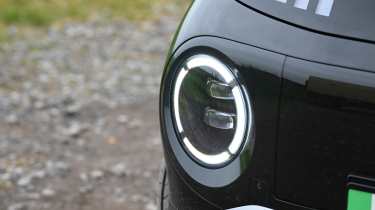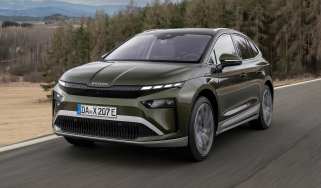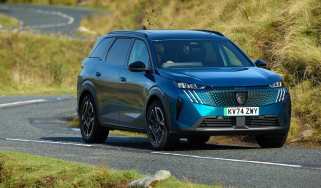Hyundai Inster review
Hyundai’s new small EV is competitively priced but still has some personality
Pros
- Funky styling
- Spacious cabin
- Good to drive
Cons
- Some safety kit only available on upper trims
- Numb steering
- Average charging speeds
Hyundai Inster verdict
The Hyundai Inster is a welcome new entrant into the affordable electric car class. It punches above its size for driver appeal, refinement and quality and the stylish exterior and funky cabin detailing give it some personality too. The pricing starts to look a little steep towards the upper end of the line-up but the basic range and performance stats, and reasonable equipment levels, justify its positioning. The most affordable model doesn’t penalise you too much either, despite missing out on some of the kit offered in 02 and Cross versions – its 203-mile range beats the basic Renault 5.
Details, specs and alternatives
The Hyundai Inster is an all-new vehicle for the UK market, but the shape is already familiar in its Korean home market as the Casper, which was sold as a basic petrol car. Here it’s fully electric and slots into the gap at the bottom of Hyundai’s EV range, and in size falls somewhere between the diddy i10 city car and the i20 supermini – with crossoverish styling that makes it funkier than either.
Pricing of £23,495 to £28,745 meanwhile means it’s aiming at the same market as the Renault 5 E-Tech, while its battery sizes and range fall between the Renault’s two extremes too: the basic Inster’s 203 miles is greater than the entry-level 5’s 193 miles, but the biggest battery in the Inster and the 229-mile range it offers falls short of the 5’s 249 miles. The Renault will prove tough competition, given it’s more overtly stylish than the Hyundai, but more competition in this segment is always welcome.
The Inster arrives in three trim levels, the not-so-imaginatively named 01 and 02, plus a range-topping Cross, which as we’ve all been conditioned to expect by now, as a bit of rufty-tufty body cladding which hints at, but probably doesn’t grant you, some off-road ability. All Insters are resolutely front-wheel drive after all, and the Cross’ ground clearance is unchanged from the standard car.
Equipment levels are generous across the range, with a standard heat pump being the most notable feature, but you’ll need 02 spec and above for the larger battery and more powerful electric motor, as well as goodies like LED headlights, a heated steering wheel and heated seats.
In addition to the fancy French Five, other Inster alternatives include the great-value and very talented Citroen e-C3, and the Citroen’s imminent cousin, the Fiat Grande Panda. In electric form the Panda starts at just over £21,000, offers 199 miles of range, and is rather stylish, so it’ll be stiff competition for the basic Inster. If you want to cut your EV costs even further, then the £15k-£17k Dacia Spring, and the £16k Leapmotor T03 (with its 165-mile range) significantly undercut the Inster on price.
Range, battery size & charging
| Range | Wallbox charge time | Rapid charge |
| 203 miles | TBC hrs (10-100%, 7.4kW) | 58mins (10-80%, 50kW) |
| 229 miles | TBC hrs (10-100%, 7.4kW) | 58mins (10-80%, 50kW) |
The Inster comes with two battery options, a 42kWh model promising a 203-mile range, and a 49kWh ‘Long Range’ model good for 229 miles on the standard 15-inch wheel option or 223 miles if you upgrade to 17-inch wheels. There’s then 73kW charging for the smaller battery and 85kW for the larger one, neither of which is particularly special these days but is about what you’d expect for a car in this class.
You’d also expect good efficiency, and the Inster delivers it on paper – the 42kWh car’s efficiency works out around 4.8mi/kWh and the 49kWh model gets 4.6mi/kWh. We didn’t quite manage this in our drive of the Long Range model with the 17-inch wheels, the 3.8kWh return working out to more like 186 miles of range, but that was on a mix of rural routes and motorways, so the average commute or city route should be a little less energy-intensive.
Running costs & insurance
Tax changes from April 2025 mean you’ll pay £10 on VED in the Inster’s first year, and then a flat rate of £195 thereafter. The latter is not any cheaper than the average petrol supermini, but won’t make a huge dent in the Inster’s overall running costs. If it happens to appear on your company car list though you’re in for some pretty affordable motoring, as Benefit in Kind rates of 3 per cent against the relatively low purchase price means bills as low as around £140 a year for a basic-rate taxpayer.
Hyundai’s five-year warranty should also keep costs down and servicing is unlikely to be too steep either. And with a low starting price, depreciation may not be as severe as more expensive EVs can be.
Performance, motor & drive
| 0-62mph | Top speed | Driven wheels | Power |
| 11.7s | 87mph | Front | 95bhp |
| 10.6s | 93mph | Front | 113bhp |
Like several electric car makers, Hyundai pairs its smaller battery pack with a less powerful electric motor, in this case 95bhp, and the larger pack with a more powerful drivetrain, at 113bhp. Those figures split the difference between the 64bhp Dacia Spring and the 118bhp entry-level Renault 5, and performance is similarly in the middle of the Dacia and Renault, with 0-62mph times in the 10-11 second range.
At 1,425kg at its absolute heaviest, the 113bhp car we’ve tried had no problem getting the Inster up to speed, feeling brisk off the mark and having enough go (and a grown-up feel) that make motorway driving pretty easy too. Large wheels and a short wheelbase can make the Inster feel a touch bouncy at low speeds but it settles down as you go faster, while the car’s small size and low-down weight give it a MINI-like nimbleness in corners – albeit without the MINI’s more engaging steering feel.
Interior, dashboard & infotainment
The Inster has a funky interior design to match its funky clothing, with a handful of cues from larger Hyundai electric cars (such as the four dot logo on the steering wheel, morse code for ‘H’) and some cheery details of its own, like the wider driver seat that incorporates a pair of cupholders and a slot for phones or keys. The doors close with a thunk rather than a clang and the lighter trim options give the cabin an airy feel.
All Insters get a pair of 10.25-inch screens, one for the driver and a central infotainment display with standard Apple CarPlay and Android Auto. Unlike a lot of modern cars, they’re not connected in a slick, single panel, but you can’t expect too much at this price. They do have the simple graphics and logical operation of other Hyundais though, while minor controls all take the form of actual physical buttons and switches. It’ll never catch on…
Boot space, seating & practicality
| Length | Width | Height | Boot space (seats up/down) |
| 3,825mm | 1,610mm | 1,575mm | 238-351 litres |
Practicality is pretty good for a relatively small car – the Inster measures in at just over 3.8 metres long, so it’s about 100mm longer than a Dacia Spring (and longer still than a Hyundai i10) and about 100mm shorter than a Renault 5. Head and legroom are good whether you’re in the front or rear seats, headroom helped by the tall body and legroom by the upright seating position.
The rear cabin gets a flat floor too, and 02 spec and above lets you tilt the rear seat back for an even greater feeling of space. At the expense of boot volume, admittedly, which varies from 238-351 litres depending on trim level and where you’ve set the rear seat. Those funky chair-mounted cupholders aside, cabin storage is only modest – some pokey door bins, a glovebox, a tiny tray above the glovebox, and a tray below the centre console controls – but no worse than most other cars this size.
Reliability & safety rating
Hyundai’s five-year warranty should go some way to easing buyers’ nerves over long-term dependability, though at the same time, a 17th-place showing in the 2024 Driver Power survey for the Hyundai brand was only mid-table, so the Korean marque clearly has room for improvement. The Inster’s simplicity may help it though, since there are simply fewer things to go wrong in a car like this than a bigger, more complex model.
Given the Inster’s novelty, we’ve also not yet seen crash test results, since Euro NCAP hasn’t put the car through its testing programme as yet. It’s not short of safety features though, including all the stuff you’d expect: seven airbags, blind spot warnings, a rear-view monitor, lane keep assist, and tech to help you avoid parking bumps, though some features are limited to the range-topping Cross. Likewise, LED headlights are only available from 02 spec.
